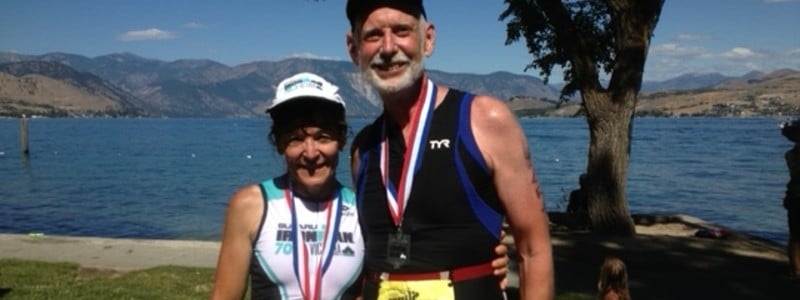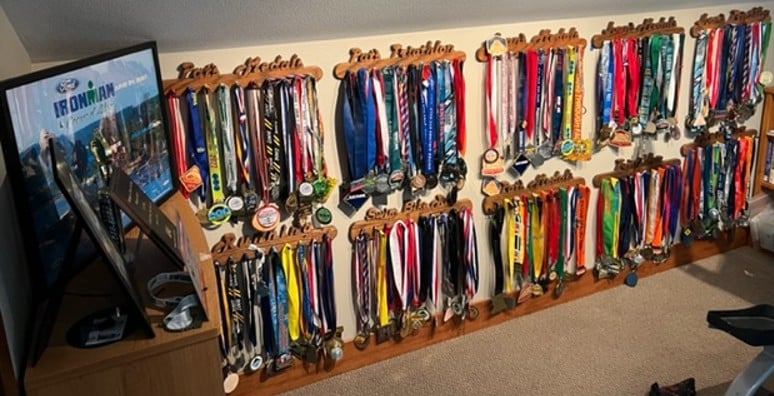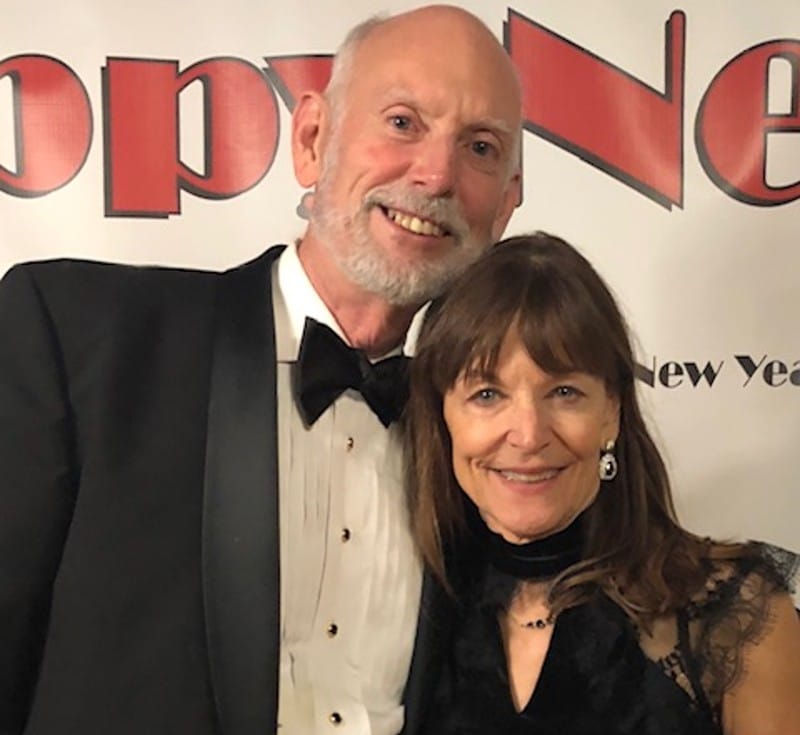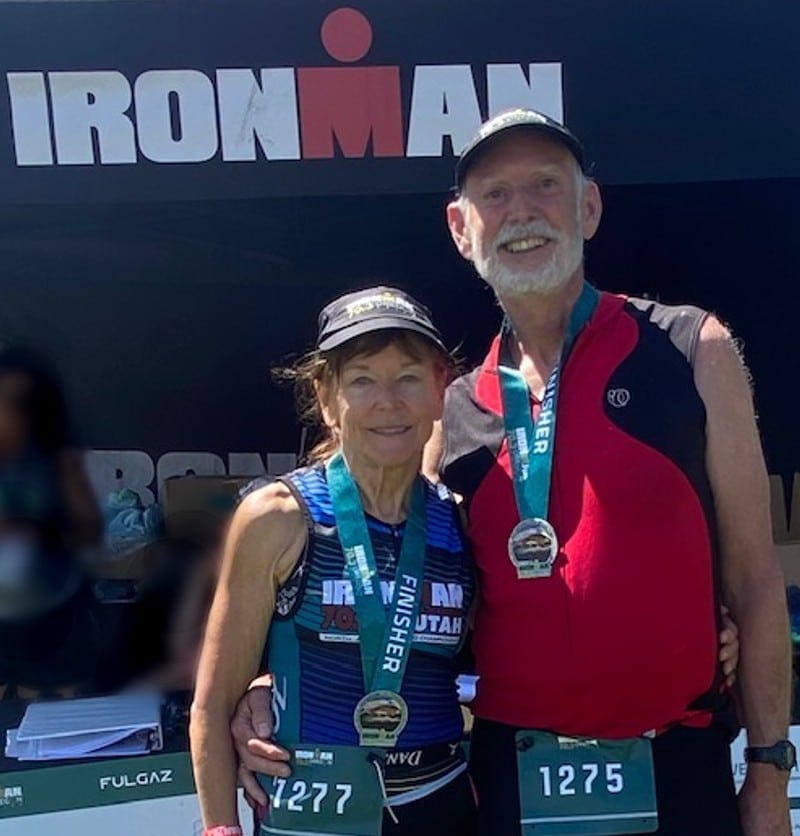Triathlon For a Healthy Brain – Pat & Joan Hogan’s Story

The physical exercise that accompanies endurance sports like triathlon supports a healthy brain. Just as our muscles adapt to the stress of weight training to become stronger, our brain adapts to new challenges.
Most of us are familiar with some benefits of what Dr. Patrick Hogan calls “challenging exercise”. For example, we know that exercise promotes cardiovascular health.
However, did you know that there is a 45% decrease in incidence of Alzheimer’s dementia in those who do an adequate duration and intensity of exercise consistently into older age? Neither did I until I spoke with Dr. Pat and Joan Hogan.
Add to this the psychological benefits of social interaction and improved thoughts of gratitude, confidence, and hope that accompany triathlon training and who shouldn’t want to get involved.
Improved brain function is an important reason Pat and Joan Hogan have continued in triathlon into their 70s. It is also why they plan to continue to train and compete in the sport as long as possible.
Who Are Pat and Joan Hogan?
I recently had the pleasure of meeting Pat and Joan, first through email and later over the phone, as they sought to connect with Craig Cross, another senior triathlete whose story appears here.
Dr. Patrick (Pat), DO, and Joan Hogan, RD, are part of the Puget Sound Neurology and Integrative Headache Center in Tacoma, Washington. Their practice is focused on treating movement disorders, migraines, and pain from other sources.
Dr. Hogan, Director of the Center, has spent much of his career treating neurological disorders such as Parkinsons and Dystonias. In fact, the National Parkinson’s Foundation has granted his Parkinson’s treatment program national recognition as a Center of Excellence.
Joan has been a Registered Dietician for over 30 years. Her specialty within the practice is testing and therapy for delayed food and food additive hypersensitivity. For many individuals, food sensitivity is a source of pain, disease, and discomfort.
Joan has also written a book titled “Nutrition for the Ailing Brain: Your Guide for Parkinson’s Disease and Other Neurological Disorders“.
Both Pat and Joan are active triathletes, having completed various distance triathlons, including half and full Ironman races.
Over 70 Years Combined Competing in Triathlon
The Hogans put into practice in their own lives what they prescribe for their patients – challenging exercise, a healthy diet, and quality sleep. Pat and Joan have a combined experience in endurance training, particularly triathlon, of over 70 years.
Pat completed his first triathlon in 1984 while serving in the Army as a neurologist at Tripler Hospital in Honolulu, Hawaii. After completing the Honolulu Marathon, a friend introduced him to triathlon.
Since he enjoyed swimming, biking, and running, Pat chose as his first triathlon an Olympic distance race in Hawaii. He has never looked back.
Joan’s experience is almost as long as Pat’s. She completed her first triathlon, an indoor race, in 1987. Like Pat, she combined her love for swimming, biking, and running as individual sports to take the leap to doing a triathlon.
While she was comfortable in a pool, swimming in the open water, especially in cold water, was another thing. After completing one triathlon involving an open water swim in cold water without a wetsuit, she hit pause on the sport for a while.
However, once Pat and Joan began training together, Pat convinced her to get a wetsuit. This addressed the cold water part of the challenge.
Demonstrating one benefit of training with a partner, Pat also helped Joan “slay the dragon” of her anxiety with the open water.
They completed their first triathlon together about 20 years ago in Ft. Louis, Washington.

What is the Relationship Between Exercise and Brain Health?
Much of the benefit of triathlon training, such as improved endurance, improved coordination, and improved speed, occurs through changes in the brain that are then transmitted to the muscles.
According to Pat, a program of challenging physical exercise, such as triathlon training, activates the chemical irisin that is released into the brain. Irisin stimulates Brain Derived Neurotrophic Factor (BDNF) which leads to formation of new brain cells. It also produces new connections within the brain. While BDNF naturally decreases with age and stress, it increases with exercise.
These new brain cells and synaptic connections improve brain function and prevent diseases, such as Alzheimer’s and Parkinson’s.
Thankfully, the areas of the brain most prone to atrophy, the hippocampus and frontal cortex, are the parts most improved by exercise since exercise-produced BDNF is most concentrated in these areas of the brain.
In humans, robust effects of exercise have been most clearly demonstrated in aging populations, where sustained exercise participation enhances learning and memory, improves executive function, counteracts age-related and disease-related mental decline, and protects against age-related atrophy in brain areas crucial for higher cognitive processes.
Carl W. Cotman, Nicole C. Berchtold and Lori-Ann Christie, Exercise Builds Brain Health: Key Roles of Growth Factor Cascades and Inflammation, Trends in Neurosciences, 30(9):464-72, October 2007.
The Hogan’s Approach to Triathlon Training
The Hogan’s take a holistic view of their triathlon training. Undoubtedly, this comes from melding their professions with the sport.
Their training includes, of course, the physical components related to endurance swimming, biking, and running and to strength training. However, equally important in their training are nutrition and rest.
While many consider nutrition and rest as ‘nice to have’ but not necessarily that important for the overall preparation for a triathlon, these two give equal importance to each of these components
Physical Training
Pat and Joan are self-coached, doing some combination of swimming, biking, and running on six of seven days per week. Today, their training is based on an intermediate Ironman 70.3 program for those over age 50 from TrainingPeaks.
A typical week involves three open water swims in the lake next to their house in Gig Harbor, Washington. A bike or a run, some which take advantage of the hills near their house, often follow these swims. There are also days for the longer, slower run with a few hill repeats added for excitement.
Besides their long bike ride on the weekends, Pat bikes the 18 miles to and from work one day each week.
Include Strength Training for Endurance and Balance
Strength training is important for all triathletes. However, the Hogans have learned first-hand that it becomes even more important as we age.
Joan commented, “I can no longer just go out for a run. I have learned through various people, including physical therapists, that I need to spend the first 20-30 minutes doing exercises to strengthen my hips, hamstrings, and core muscles. Otherwise, ‘things’ breakdown.”
Related Post: Better Balance Makes A Stronger Triathlete
Cross Training for Both Endurance and Brain Health
“To improve the brain, we must continually challenge it. That’s why exercise that requires skilled coordination provides greater brain stimulation,” says Pat Hogan.
“That the brain changes as we challenge it is called neuroplasticity. However, if you do the same thing over and over again, the brain does not have a reason to adapt.”
This is one reason that triathlon, with its three technical sports, along with strength training, supports a healthy brain.
It is even better for our brain health when we combine triathlon training with activities outside endurance sports. Examples include ballroom dancing, music, learning a new language, and golf. (It encouraged me to learn that my brain can also benefit from practicing and playing golf with its challenges.)

Nutrition for the Senior Triathlete
Led by Joan’s passion for nutrition and brain health, the Hogan’s follow a vegetarian diet. This choice was initially based on environmental and animal welfare concerns. Nutrition was a third reason for choosing to follow this diet.
According to Joan, “No matter what type of diet you choose, your diet must it be high in plants, seven or eight servings of vegetables per day.”
She emphasized it is critical that seniors get enough protein in their diet to offset the trend toward muscle loss with age. The amounts of protein she recommends for seniors are greater than that for the average population.
- women: at least 30 grams three times per day (plus 50% per meal more while training for an Ironman distance race).
- men: at least 40 grams three times per day (plus 50% per meal more while training for an Ironman distance race)
Joan recommends consuming some of the protein before exercise, even if only half of that for a complete meal. “A half a banana with a slab of peanut butter or a protein smoothie before exercising is great.”
Here is an interesting point. According to recent research, it may even be more important for women than men to consume carbohydrates and protein before exercise..
Plant-Based Protein
According to Joan, the amounts of protein recommended for senior triathletes are available from plant-based sources. Her ‘go-to’ sources include organic soy (tofu, tempeh, and edamame), seitan (made from wheat gluten), peas, nuts, nut butters, and various beans. The Hogans sometimes supplement plant sources with whey, eggs (from their chickens), and cheese.
She also mentioned that a serving of pasta from chickpeas, black beans, and lentils is high in protein. “One serving of these contains the protein in a piece of meat.”
Joan warns it is more difficult, though not impossible, for those on a vegan diet to get the recommended amounts of protein. “It takes a lot of work to get the required amounts of protein.”
Related Post: What Masters Athletes Need To Know About Nutrition
The Healing Process Called Sleep
During sleep, our cerebral lymphatic system clears out from the brain, toxins and unused proteins generated during the waking hours. In the process, neurotransmitters in the brain are regenerated.
Interestingly, this regeneration only works during sleep, making it an important reason to get enough quality sleep each day.
Cutting sleep short prevents the healing from fully occurring. Complete healing is especially necessary for seniors because we already have a lower ‘neuronal reserve’ on which to rely as we age.
According to Pat and Joan, getting at least eight hours of sleep each day is so important that if you have to choose between sleeping and doing the workout, choose sleep. Don’t cut your sleep short because the benefits of your training will suffer from doing a workout without being adequately rested.
Related Post: Rest and Recovery: Why It’s Important for Senior Triathletes
Start Now and Never Stop!
If you are not doing a challenging exercise, start. That is the impassioned advice from the Hogan’s.
Don’t Wait . . .
“Our brain has a natural trajectory toward loss of balance and slowness of thought, if not actual dementia. The brain requires the medication of exercise to present this from happening. We call this medication Doesital (a term coined by Pat) and with diet, it is Doesital forte.
“Some say they will start later or take a break. We are all paddling upstream on a river, away from waterfalls. Once you go over the waterfalls, you can not go back up. We can avoid this irreversible fall with persistent exercise.”
And, Don’t Stop
Pat and Joan are committed to continuing in the sport of triathlon as long as they can, despite aging bodies.
Some think of our body as a machine with parts that require periodic replacement. However, this is not a correct view, according to Pat.
“Our bodies are much better than machines. Our joints are bio-mechanical, not simply mechanical, which means they adapt to stress and become stronger with use.”
Joan added, “Most problems that result in pain with exercise can be fixed without surgery.”
The author of “Runners Are Less At Risk Of Knee Arthritis Than Sedentary Populations” cites a 2018 paper which concludes:
“veteran marathon runners studied were actually around 50% less likely to develop knee arthritis than the non-runner comparison group.”
The author of this article also cited a paper published in the European Journal of Physiology which documents lower inflammation in knee joint fluid and blood serum following a 30 minute run.
Tips to Avoid Stopping
The Hogans have learned to be consistent with their training – exercise, diet, and rest. Here are tips they offer to help avoid quitting, especially when our body may initially seem to argue against exercising.
1. Make exercise a habit, part of your daily routine
When you have made something a habit, an unconscious part of your life, motivation is no longer required.
How do you make exercise a habit? Pat and Joan say that at the beginning it helps to “embrace some short-term discomfort as a means to longer term comfort”.
2. Train with a partner
The Hogans have the benefit of being each other’s spouse and training partner. They are able to better encourage each other because they understand one another’s schedules and the current demands upon them.
However, there are many other options for supporting senior triathletes on their journey, including Our Community on SeniorTriathletes.com, local triathlon clubs, and live and virtual coaches.
Let us know if you can use some help to find a support group for your triathlon journey.

3. Add some incentive by signing up for races
Paying the registration fee for a triathlon adds a new level of incentive to prepare for a triathlon. Most of us want to show up to the race knowing we have done what we could to complete the race, earn the t-shirt and finisher medal, and celebrate with other triathletes and our family and friends, even if they are watching from the sidelines – for now.
Final Remarks
Having seen the effects of a sedentary lifestyle and/or poor diet in their practice, Pat and Joan Hogan are on a crusade to convince those over age 50 to get into a habit of combining challenging physical exercise with an appropriate diet and quality sleep – for their body and their brain.
A little, short-term discomfort during exercise leads to a more comfortable life physically and a clearer mind. Besides, the training improves our thoughts of gratitude, confidence, positive attitude, hope, and inspiration that expand to all aspects of our daily life.
Further Reading Related to Brain Health
Following are sources of additional information about the relationship between “challenging exercise” and brain health provided by Pat Hogan.
Books
Spark: The Revolutionary New Science of Exercise and the Brain by John J. Ratey MD and Eric Hagerman.
The Telomere Effect: A Revolutionary Approach to Living Younger, Healthier, Longer by Dr. Elizabeth Blackburn and Dr. Elissa Epel.
Move Your DNA: Restore Your Health Through Natural Movement by Katy Bowman.
Articles
How Exercise Benefits Brain Health by Vernon Williams, MD; US News & World Report.
4 Key Features of a “Sports Brain” by Vernon Williams, MD
Have Questions or Thoughts for Pat and Joan?
Share your questions and comments in the Comments section below.

I agree, sleep and nutrition are as important as the physical side of racing. Good article.